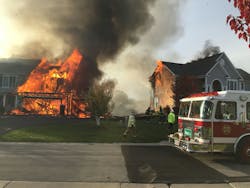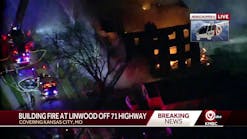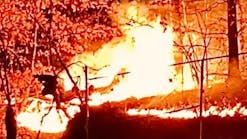On the Job: New York - Crews Battle Fire in Two Houses
On Oct. 27, 2015, several New York departments responded to a two-alarm fire that involved two houses and threatened a third in a Victor, NY, subdivision. Among the numerous photos of this incident, Assistant Fire Chief Mark Eifert says it is the least dramatic image that may best capture the tense moments when he and Assistant Fire Chief Sean McAdoo arrived on scene ahead of first-due apparatus.
The photo to which Chief Eifert refers shows him walking down Camden Hill Drive during his initial 360-degree size-up, approximately 5 minutes after the Victor Fire Department, Fishers Fire Department and Farmington Fire Department were dispatched on the first alarm. Outside the frame of the picture, the fire has engulfed one-third of one house and extension into the second house, the D-side exposure, is imminent.
Chief Eifert, who is a trooper and fire investigator with the New York State Police in addition to his service with the all-volunteer Victor Fire Department, was driving in his personal vehicle when the Ontario County 9-1-1 Center broadcast a pre-alert to the first-alarm departments.
“I just happened to look toward the east and saw the rising plume of black smoke, before our tones even went off,” says Chief Eifert, who was assigned as the operations officer by Chief McAdoo, the incident commander (IC). “My first two thoughts were that it was a large fire and it had a significant head start on us. During my response, the subdivision was in chaos. A large number of vehicles and onlookers were on Camden Hill Drive, and I actually had to avoid a passenger car driving toward me, on my side of the street.”
The Victor Fire Department is well equipped, well trained and ably led. Yet, as is the challenge for volunteer departments, response time and the number of firefighters who can respond varies by the hour and day. To meet this challenge, Victor works closely with neighboring departments, including Fishers, which is staffed with a combination of career and volunteer personnel.
Initial size-up
“My initial reaction exiting my truck was how intense the heat was. It reminded me of fighting barn fires when I was younger,” Chief Eifert says. “The three-car garage and its second story were completely engulfed in flames on the main house. Flames were well over the roofline in height. The exposure house had all the siding melted off on the B side, and pyrolysis could be seen on the plywood sheeting, running up the B/C corner. For the second time, I thought what a significant head start the fire had and how we were already way behind. I knew the exposure house would start burning and there was nothing I could do about it.”
During his size-up, Chief Eifert met up with Fishers Deputy Chief Ryan Miller, who arrived in a command vehicle, yet the command team was still without fire apparatus or firefighters. Victor and Fishers would exceed the NFPA 1720 deployment standard for a primarily volunteer response to a suburban structure fire by placing 14 firefighters on the scene within 10 minutes of the initial alarm. Still, for Chief Eifert, the 4 minutes that passed after Chief McAdoo and he arrived and before Victor Ladder 2781 came around the corner were excruciating.
“My walk down Camden Drive toward the B side of the main house was very lonely and eerily quiet,” Chief Eifert says. “I was intently listening to hear a Federal Q in the distance, but heard none. I had no resources, and I did not know what I would be getting and whether or not I could implement my operational plan of attacking both houses at once. When I got to the front lawn, I heard the report that people were trapped in the main house. I still had no idea of what apparatus or the type and capability of the resources I would be getting. Suddenly, I had to prioritize the objective of conducting a rescue, in addition to the extinguishment of two fires. On the D side, I found an open door and noted the house was charged with light wispy grey smoke. I called inside but did not receive a reply. I closed the door and eliminated the potential flow path. When I got back to the A side, Chief Miller was on the porch, packed up and preparing to enter the front door. He asked if he should go in for a primary search. My immediate thought was I would not ask him to do that alone and unprotected by a hoseline, although I saw the interior conditions and felt they were viable for a rescue. Fortunately, I did not have to finalize that decision as we got word that all occupants were accounted for, and I let Chief Miller know. For me, this dilemma was probably the toughest 5 or 10 seconds of the entire call. As I returned to the front of the houses, the exposure had flames rolling up the B side and black smoke was coming out of several roof vents. The radiant heat from the fully-involved garage vaporized the vinyl siding on the exposure and ignited the exterior sheeting despite 28 feet of separation and minimal wind. On the opposite side of the fireground, 24 feet separated the structure of origin from another exposed house that firefighters would spare from any damage."
Hitting the fire
Chiefs Eifert and McAdoo found themselves on the fireground during the span of time between circumstances that are beyond firefighters’ control and when firefighters can rein in a rapidly deteriorating situation with solid preplanning, training, tactics and incident command.
In less than 8 minutes after Chief Eifert and Chief McAdoo arrived, however, the first 14 volunteer and career firefighters on scene had deployed. Water supply was established from separate hydrants to both first-arriving apparatus. A superb hit was made on the main body of fire in the structure of origin. Fire on the exterior of the exposure was knocked down, and a crew pushed inside, pulled ceilings and suppressed fire in the attic. As soon as the main body of fire in the structure of origin was knocked down, interior operations were initiated there as well.
Fire response
Ultimately, 69 firefighters and command staff from six departments and additional personnel from EMS, law enforcement and other ancillary agencies were on scene under a command structure that smoothly divided the incident into two distinct operations.
“We are fortunate to 'practice' the Command-Operations roles at every call, as we usually have two or more chiefs on even routine scenes,” explains Chief McAdoo, who requested the Egypt Fire Department for rapid-intervention crew duties in his initial situation report, then upgraded the request to a full second alarm moments later. “Without thinking about it, the senior officer establishes Command and the next takes Operations. When we're down to just one chief, and two apparatus arrive, we usually assign the first company officer to the Operations position. We've gotten to the point that we hardly even need to talk about strategic decisions. Command makes the call; Operations makes it happen.”
Play-by-play
The fire began because a homeowner put hot coals from a smoker into a plastic container in the garage and went into his house. Alerted by shotgun shells going off in the garage as a result of the ensuing fire, the homeowner attempted to use a garden hose on the flames before dialing 9-1-1.
Video of the burning garage was posted on social media by a neighbor at least 4 minutes before the Ontario County 9-1-1 Center received the first report of the fire and dispatched the initial alarm assignment at 4:35 p.m.
Ladder 2781, a quint apparatus, arrived with six personnel at 4:43 p.m. Fishers Engine 912 arrived 2 minutes later with three personnel. Chief officers from the two departments and a Victor firefighter who arrived in his personal vehicle brought initial fireground staffing to 14.
Ladder 2781 driver Gerald Barry and Engine 912 driver Rich Loce approached the scene from opposite directions, which enabled suppression efforts in both structures to be initiated simultaneously as Chief Eifert planned. Barry positioned Ladder 2781 in front of the structure of origin. Loce laid a supply line from a hydrant on the way in and pulled just beyond the involved exposure, and his engine placement provided critical space when a ladder from Egypt arrived.
Victor Lieutenant Justin Kennedy and Firefighter Jason Maier deployed a 2½-inch line from Ladder 2781 between the structure of origin and the involved exposure. Victor Firefighter Tom Simonds utilized the aerial master stream to protect the uninvolved exposure on the B side.
Fishers Firefighter Andrew Goole and Firefighter Drew Cusimano deployed a 2-inch line from Engine 912, hit the exterior of the exposure and then rapidly advanced inside and to the attic.
After Victor Firefighter Jon McConnell hand laid a supply line from Ladder 2781 to a hydrant, McConnell, Firefighter Robert Green and Firefighter Mark Years advanced a 2-inch line to the front of the structure of origin. Joined by Fishers Fire Chief Andy Stromfeld, the attack team pushed inside, made their way to the second floor and went after fire in that attic.
The fire in the exposure was declared knocked down at 4:52 p.m., 17 minutes after the initial alarm. The fire in the structure of origin was declared knocked down at 5 p.m., 25 minutes after the initial alarm. At 5:23 p.m., the fire was called under control as second-alarm crews sustained interior operations that had transitioned from the initial exterior attacks.
“I feel that transitional attack is really an ‘old school’ firefighting tactic that now is supported by facts afforded us by science,” says Chief Stromfeld, a volunteer firefighter since 1980 and a retired police officer with the New York City Police Department Emergency Service Unit. “A quick and precise hit from the exterior still needs to be followed by a safe, yet aggressive, interior attack. As we experienced here, the exposure D house fire was handled this way. I believe had the time been taken to stretch to the seat of the fire with the short crew available that day, vital time would of passed, allowing the fire a firmer grip on the structure. With today’s lightweight construction, we do not have that time.”
Resources are key
Chief Stromfeld, Victor Fire Chief Joe Murphy and their personnel have accomplished what amounts to functional consolidation of two fire departments, three stations, Fishers’ career personnel and volunteers with both organizations, which jointly protect the 36-square-mile Town of Victor. Chief Stromfeld is engaged in a concerted effort to increase Fishers’ on-duty career staffing to four personnel and ensure rapid response times around-the-clock. He and Chief Murphy strive to avoid burnout of volunteers by utilizing Fishers’ career personnel to handle activated fire alarms, EMS calls and other incidents that do not require a labor-intensive response. Their objective is to be able to depend on their volunteers when they need them the most, as occurred on Camden Hill Drive.
“This incident shows how fast response from multiple crews of a minimum of four per rig is needed to get control of these things as quickly as possible,” states Chief Stromfeld in comments posted on the Fishers Professional Firefighters and Drivers Facebook page. “There’s a reason that’s an NFPA recommendation.”
The second-alarm assignment, which included Canandaigua, East Bloomfield and Farmington, was en route to Victor when personnel on the responding apparatus observed the dark plume of smoke change to a billowing cloud of white steam. On arrival, officers from the three departments were inserted into the command structure and firefighters were rotated into extensive overhaul operations.
Chief McAdoo states that incident command practices among the multiple departments at the scene have become seamless.
“Earlier this year, we arrived on location in Fishers to a scene where several houses were struck by lightning,” McAdoo says. “A single command was established, and two separate operation sections were established. It was almost a practice run for this fire. Last winter, at a townhouse fire in Farmington, I was operations and ended up assigning three divisions, one for each townhouse. On weather events, command is established at our firehouse, and company officers take charge on individual scenes as operations. These prior events are critical to the fire scenes we run. It's created a discipline that our departments just snap into.”
Mark Marentette
Mark Marentette is the fire chief of the Canandaigua Fire Department in New York. He has been in the fire service since 1986, and a chief officer since 1996. He completed the Executive Fire Officer Program at the National Fire Academy, and has earned a master’s degree in public administration from Bowling Green State University and a bachelor’s degree in communications from Oakland University.






